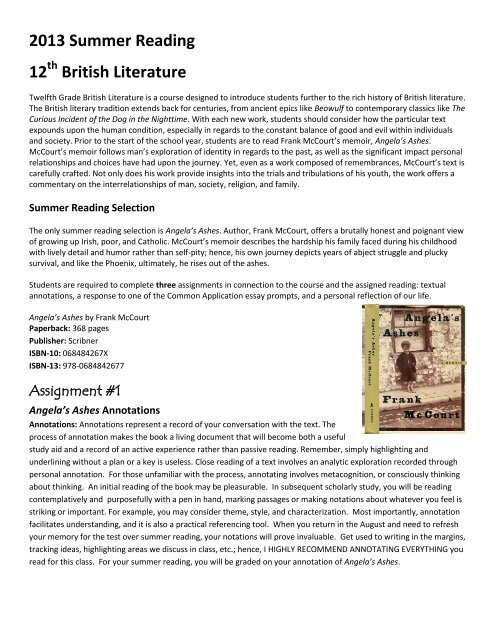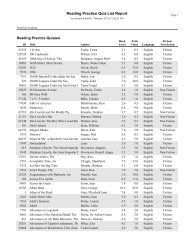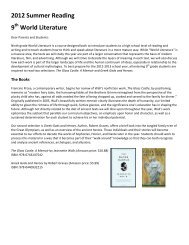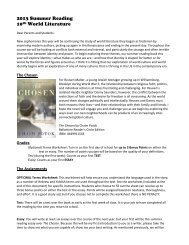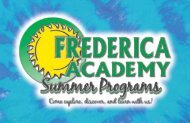Rising Twelfth Grade British Literature - Frederica Academy
Rising Twelfth Grade British Literature - Frederica Academy
Rising Twelfth Grade British Literature - Frederica Academy
You also want an ePaper? Increase the reach of your titles
YUMPU automatically turns print PDFs into web optimized ePapers that Google loves.
2013 Summer Reading12 th <strong>British</strong> <strong>Literature</strong><strong>Twelfth</strong> <strong>Grade</strong> <strong>British</strong> <strong>Literature</strong> is a course designed to introduce students further to the rich history of <strong>British</strong> literature.The <strong>British</strong> literary tradition extends back for centuries, from ancient epics like Beowulf to contemporary classics like TheCurious Incident of the Dog in the Nighttime. With each new work, students should consider how the particular textexpounds upon the human condition, especially in regards to the constant balance of good and evil within individualsand society. Prior to the start of the school year, students are to read Frank McCourt’s memoir, Angela’s Ashes.McCourt’s memoir follows man’s exploration of identity in regards to the past, as well as the significant impact personalrelationships and choices have had upon the journey. Yet, even as a work composed of remembrances, McCourt’s text iscarefully crafted. Not only does his work provide insights into the trials and tribulations of his youth, the work offers acommentary on the interrelationships of man, society, religion, and family.Summer Reading SelectionThe only summer reading selection is Angela’s Ashes. Author, Frank McCourt, offers a brutally honest and poignant viewof growing up Irish, poor, and Catholic. McCourt’s memoir describes the hardship his family faced during his childhoodwith lively detail and humor rather than self-pity; hence, his own journey depicts years of abject struggle and pluckysurvival, and like the Phoenix, ultimately, he rises out of the ashes.Students are required to complete three assignments in connection to the course and the assigned reading: textualannotations, a response to one of the Common Application essay prompts, and a personal reflection of our life.Angela’s Ashes by Frank McCourtPaperback: 368 pagesPublisher: ScribnerISBN-10: 068484267XISBN-13: 978-0684842677Assignment #1Angela’s Ashes AnnotationsAnnotations: Annotations represent a record of your conversation with the text. Theprocess of annotation makes the book a living document that will become both a usefulstudy aid and a record of an active experience rather than passive reading. Remember, simply highlighting andunderlining without a plan or a key is useless. Close reading of a text involves an analytic exploration recorded throughpersonal annotation. For those unfamiliar with the process, annotating involves metacognition, or consciously thinkingabout thinking. An initial reading of the book may be pleasurable. In subsequent scholarly study, you will be readingcontemplatively and purposefully with a pen in hand, marking passages or making notations about whatever you feel isstriking or important. For example, you may consider theme, style, and characterization. Most importantly, annotationfacilitates understanding, and it is also a practical referencing tool. When you return in the August and need to refreshyour memory for the test over summer reading, your notations will prove invaluable. Get used to writing in the margins,tracking ideas, highlighting areas we discuss in class, etc.; hence, I HIGHLY RECOMMEND ANNOTATING EVERYTHING youread for this class. For your summer reading, you will be graded on your annotation of Angela’s Ashes.
For Angela’s Ashes, annotate as you read, making notes over the following:Annotations are a record of your conversation with the text. The process of annotation makes the book a livingdocument that will become both a useful study aid and a record of an active experience rather than passive reading.Remember, simply highlighting and underlining without a plan or a key is useless. I HIGHLY RECOMMEND ANNOTATINGEVERYTHING you read for this class. Get used to writing in the margins, tracking ideas, noting areas we discuss in class,etc.[1] Annotate – v. To furnish (a literary work) with critical commentary or explanatory notes [ad near + nota a mark,note]Inside Front Cover:Inside Back Cover:Chapter summaries/titles:Underline:Keep a character list with a small space for character summary and for page references for keyscenes, moments of character development, etc.Make note of your thoughts about Themes, allusions, images, motifs, key scenes, plot line,epiphanies, etc. List and add page references and/or notes as you read.To me, this is the most important and most valuable part of annotating. At the end ofeach chapter, write a brief summary of the plot as it occurred in that chapter. This doesnot have to be long or greatly detailed, but should include all relevant incidents. Supplyan instructive title for each chapter of the book. This may prove useful even for books inwhich chapters are already titled. This practice will help you solidify your understandingof a chapter in just a few of your own words.Within the text of the book, and as you read, underline or otherwise note anything thatstrikes you as important, significant, or memorable. If possible and profitable, writebrief comments within the side margins that indicate your reason in underlining. Focuson essential stylistic devices (allusions, diction, syntax, imagery, literary devices, tone)and elements of literature (plot, setting, characterization, point of view and theme).Often, I underline isolated words and phrases. Occasionally, I connect such underliningswith a line, in essence creating a new sentence, a distillation of ideas or meaning. For Angela’sAshes, consider paying particular attention to the following:Anti-English sentimentAshesClass struggleDrinking/ Abuse of alcoholEducationEggsFamilyGuiltStories, songs, & folktalesHopeIrish cultureManhoodObstaclesPovertyReligionThe River Shannon
Brackets:Vocabulary/unusual diction:Questions:Shifts:Use brackets, as you read, together with abbreviations and symbols to indicate passages(too long to underline) that contain important themes, wonderfully nuanced descriptions,especially delightful phrasing and/or syntax, provocative assertions, and figurative language.And, of course, write comments and analytical snippets to clarify your thinking.Within the text of the book, circle words that are unfamiliar to you or whose use strikesyou as unusual or inventive. Look up words in a dictionary that seem essential to anunderstanding of the meaning or the sense of the author. If it helps to do so, jot a briefdefinition or synonym nearby.Actively engage the text and further/confirm your understanding of each chapter by writing atleast two open ended questions for each. Short essay questions are most useful.Note all shifts in point of view. Note all shifts in time. Note all shifts in diction and syntax.The Process:There are a number of procedural expectations that make annotation practical and effective.1. Implement a consistent system. Use the same abbreviations and symbols; these notations may includeabbreviations of character’s name, motifs and symbols, and themes (for example PL for “Personal Legend).2. Use one color ink or pencil to make initial markings while reading; then go back with another color or colors tomark more thoroughly once you have finished a larger section and have had time to think about it. Why? Youmay change your mind or get it wrong the first time, or subsequent discoveries may prompt a reevaluation ofearlier findings. It is also good to use a different color when we discuss portions of the novel in class. This allowsyou to see quickly what we thought was important and, therefore, what is most likely to be on the test. For myown annotations, I use either a pencil or pen for my first reading; I then use light green, yellow, and orange felttip pens to group annotations by character, theme, etc. The “Flair” pens by Paper Mate are my favorite pens.3. Do underlining, bracket notations, and circling as you read.4. At chapter or section ends, stop to index page numbers on your front cover list of character information andtraits as well as on your back cover list of themes, images, allusions, etc. Also, write chapter summaries at thattime.5. Be neat and be disciplined. The notations will allow you to quickly find important details when reviewing for atest or looking for supporting evidence when writing a paper.Think critically about what you are reading. Many students complain that annotating slows down their reading. This istrue. However, the goal is not to read quickly, but to consider thoroughly what you are reading. While the amount ofannotation may vary widely from page to page, any thoughtful notes you add to a text will help you to read morecritically.Effectively reading, annotating, and writing about literature are all processes that will continue to develop throughoutyour academic career.These Annotation Instructions have been adapted from Chris Rokous’s excellent guide to annotating which, in turn, was in part inspiredand informed by “How to Mark a Book,” an essay by Mortimer J. Adler, Ph. D
Assignment #2(Revised from the assignment given out before the end of school)Common Application EssayIn preparation for completing your applications for college, please complete oneof the following essays.Instructions:The essay demonstrates your ability to write clearly and concisely on a selected topic and helps you distinguish yourselfin your own voice. What do you want the readers of your application to know about you apart from courses, grades, andtest scores?Choose the option that best helps you answer that question and write an essay of no more than 650 words, using theprompt to inspire and structure your response. Remember: 650 words is your limit, not your goal. Use the full range ifyou need it, but don't feel obligated to do so. (The application won't accept a response shorter than 250 words.)Some students have a background or story that is so central to their identity that they believe their applicationwould be incomplete without it. If this sounds like you, then please share your story.Recount an incident or time when you experienced failure. How did it affect you, and what lessons did youlearn?Reflect on a time when you challenged a belief or idea. What prompted you to act? Would you make the samedecision again?Describe a place or environment where you are perfectly content. What do you do or experience there, and whyis it meaningful to you?Discuss an accomplishment or event, formal or informal, that marked your transition from childhood toadulthood within your culture, community, or family.**Please note: Mrs. Nevins will also ask you to create a response to one of the available prompts. The essay that youcomplete as part of your summer assignment must be different than the one you submit to Mrs. Nevins.Assignment #3The Soundtrack of Your LifeMusic has become an integral part of human existence. It motivates us, calms us, inspires us, at times irritates us, andbasically becomes the backdrop against which we live our lives. Songs can bring vivid memories of persons, places, andevents from our own past and serve to document our thoughts, feelings, and emotions at a given time or place.Part I: Create the SoundtrackChoose at least eight events from your life and pick out a song to accompany each event. Just as music producers do, tryto create a progression in the sequence of your chosen songs. For example, your songs might be listed in thechronological order of the events they document, orSong Title, Artist or Groupthey might be mixed together so that all of the slowTrack 1 ______________________________________________ songs are not back-to-back. DO NOT just list themrandomly. Put some thought into the order of yourTrack 2 ______________________________________________songs and the complete package you are presenting.Track 3 ______________________________________________ Feel free to go beyond the required eight songs.Track 4 ______________________________________________Track 5 ______________________________________________Track 6 ______________________________________________Track 7 ______________________________________________Track 8 ______________________________________________Part II: ExplainNow that you have created the imaginary soundtrackto your life, write a reflective letter (addressed to“Dear Listener,”) that explains why you chose theparticular songs that you did. For each song you will


